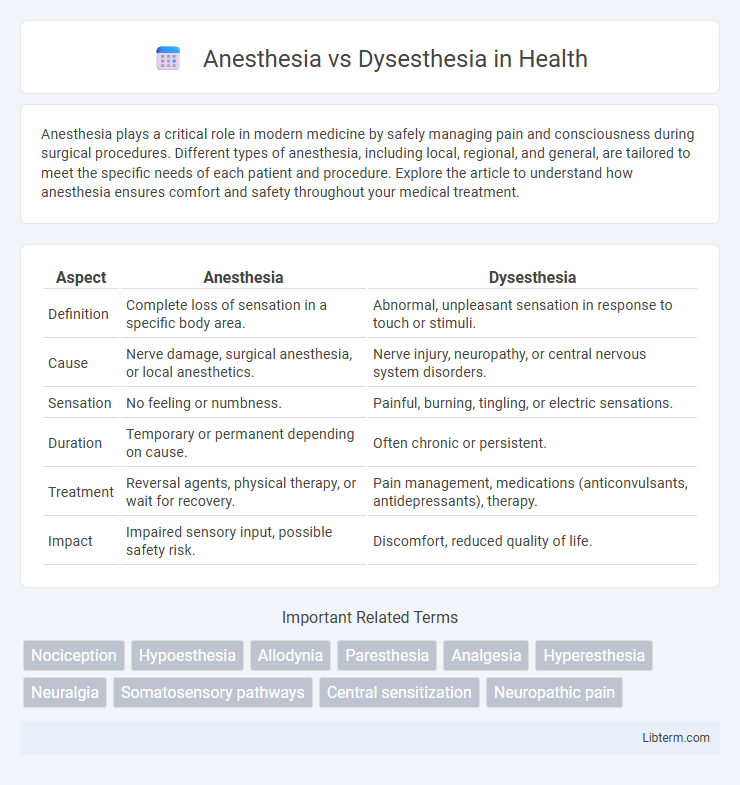Anesthesia plays a critical role in modern medicine by safely managing pain and consciousness during surgical procedures. Different types of anesthesia, including local, regional, and general, are tailored to meet the specific needs of each patient and procedure. Explore the article to understand how anesthesia ensures comfort and safety throughout your medical treatment.
Table of Comparison
| Aspect | Anesthesia | Dysesthesia |
|---|---|---|
| Definition | Complete loss of sensation in a specific body area. | Abnormal, unpleasant sensation in response to touch or stimuli. |
| Cause | Nerve damage, surgical anesthesia, or local anesthetics. | Nerve injury, neuropathy, or central nervous system disorders. |
| Sensation | No feeling or numbness. | Painful, burning, tingling, or electric sensations. |
| Duration | Temporary or permanent depending on cause. | Often chronic or persistent. |
| Treatment | Reversal agents, physical therapy, or wait for recovery. | Pain management, medications (anticonvulsants, antidepressants), therapy. |
| Impact | Impaired sensory input, possible safety risk. | Discomfort, reduced quality of life. |
Introduction to Anesthesia and Dysesthesia
Anesthesia is the medical condition characterized by the complete or partial loss of sensation, often induced deliberately during surgical procedures to prevent pain and discomfort. Dysesthesia, in contrast, refers to an abnormal and often unpleasant sensation, typically described as burning, itching, or electric shocks, resulting from nerve damage or neurological disorders. Understanding the distinction between anesthesia and dysesthesia is crucial for accurate diagnosis and effective management of sensory nerve-related conditions.
Defining Anesthesia: Causes and Symptoms
Anesthesia is the complete loss of sensation in a specific area of the body, commonly caused by nerve damage, trauma, or medical procedures such as surgery or local anesthetic injections. Symptoms of anesthesia include numbness, absence of pain perception, and lack of tactile response, which help prevent sensation during medical interventions. Understanding the causes, such as nerve compression, neuropathies, or chemical agents, is crucial for accurate diagnosis and effective treatment.
Understanding Dysesthesia: Overview and Characteristics
Dysesthesia is a neurological disorder characterized by unpleasant, abnormal sensations often described as burning, electric shocks, or itching without an external stimulus. Unlike anesthesia, which involves a loss of sensation or numbness, dysesthesia causes heightened and painful sensory perception that significantly impacts quality of life. This condition commonly results from nerve damage, multiple sclerosis, or peripheral neuropathy, necessitating targeted treatment approaches for symptom management.
Key Differences Between Anesthesia and Dysesthesia
Anesthesia refers to the complete loss of sensation, including pain, touch, and temperature, typically induced during medical procedures to prevent discomfort. Dysesthesia is characterized by abnormal, often unpleasant sensations such as burning, tingling, or pain, resulting from nerve damage or neurological conditions. The key difference lies in anesthesia causing numbness and absence of sensation, while dysesthesia involves distorted or painful sensory experiences despite the presence of sensation.
Underlying Mechanisms: Pathophysiology Compared
Anesthesia results from the reversible blockade of nerve conduction, primarily through the inhibition of voltage-gated sodium channels, leading to the loss of sensory perception. Dysesthesia arises from abnormal or ectopic nerve firing caused by nerve injury or dysfunction, involving maladaptive central and peripheral sensitization mechanisms such as altered ion channel expression and neuroinflammation. Both conditions reflect distinct pathophysiological processes: anesthesia involves controlled interruption of normal neural signaling, while dysesthesia entails pathological excitability and misprocessing of sensory input.
Common Causes and Risk Factors for Each Condition
Anesthesia commonly results from nerve damage, spinal cord injuries, or peripheral neuropathy caused by diabetes, infections, or trauma, with risk factors including surgeries, chronic diseases, and exposure to neurotoxic agents. Dysesthesia often arises due to nerve dysfunction from conditions such as multiple sclerosis, chemotherapy-induced neuropathy, or postherpetic neuralgia, influenced by risk factors like autoimmune disorders, cancer treatments, and viral infections. Both conditions involve abnormal nerve signals but differ in sensory loss versus abnormal sensations, making accurate diagnosis crucial for targeted treatment.
Diagnostic Approaches: How to Distinguish Anesthesia from Dysesthesia
Diagnostic approaches for distinguishing anesthesia from dysesthesia primarily involve detailed patient history and sensory examination. Anesthesia is characterized by a complete loss of sensation, detected through objective tests like light touch and pinprick assessments, whereas dysesthesia presents as unpleasant, abnormal sensations often described as burning or tingling. Electrophysiological studies and quantitative sensory testing (QST) further assist in differentiating these conditions by evaluating nerve function and sensory thresholds.
Treatment Options and Management Strategies
Anesthesia treatment primarily involves addressing the underlying cause, such as nerve damage or systemic conditions, with options including physical therapy, medications like analgesics or corticosteroids, and sometimes surgical intervention. Dysesthesia management focuses on symptom relief through anticonvulsants (e.g., gabapentin), antidepressants (e.g., amitriptyline), and topical agents like capsaicin or lidocaine patches to reduce abnormal nerve sensations. Both conditions benefit from multidisciplinary approaches incorporating patient education, lifestyle modifications, and regular monitoring to optimize functional outcomes and quality of life.
Patient Experiences: Impact on Quality of Life
Anesthesia causes a complete loss of sensation, often leading to temporary numbness and an inability to perceive pain, which can provide relief during medical procedures but may result in vulnerability to injury without protective feedback. Dysesthesia involves abnormal, often painful sensations such as burning or electric shocks, significantly disrupting daily activities and causing chronic discomfort that diminishes overall quality of life. Patients experiencing dysesthesia frequently report heightened emotional distress and impaired sleep, highlighting the severe impact on mental and physical well-being compared to the typically transient sensory absence in anesthesia.
Prevention, Prognosis, and Future Directions
Anesthesia, characterized by complete loss of sensation, and dysesthesia, marked by abnormal, often painful sensations, both require precise prevention strategies centered on minimizing nerve damage during surgical or medical procedures. Prognosis varies widely; anesthesia often resolves with nerve recovery or treatment, whereas dysesthesia may persist due to nerve hypersensitivity or chronic neuropathic changes, demanding tailored pain management approaches. Future directions emphasize advancements in neuroprotective agents, regenerative medicine, and neuromodulation techniques to improve sensory nerve healing and reduce the incidence and severity of these sensory disorders.
Anesthesia Infographic

 libterm.com
libterm.com